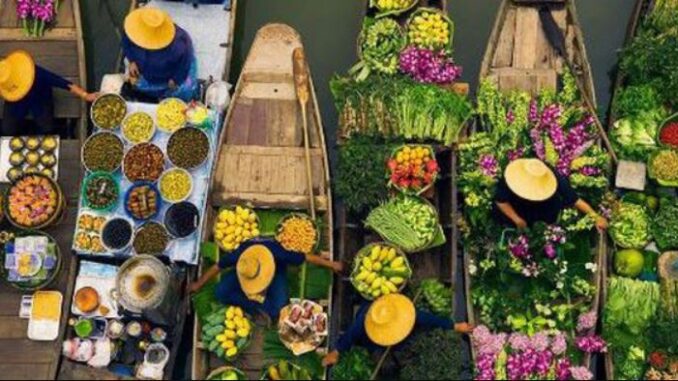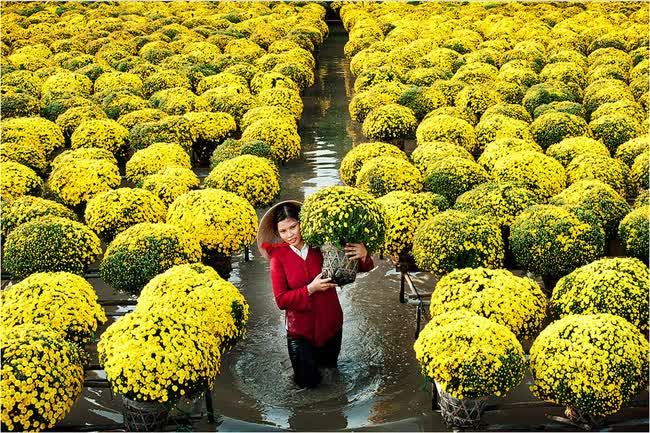
There are many ways to travel in Vietnam. You can explore a city with a long history, enjoy the blue sea under the hot tropical sky or visit the highlands to feel the life of the ethnic minorities.
Another way is to enjoy the life of the people in the West along the Mekong River carrying heavy alluvium. Flowing through China, Myanmar, Thailand, Laos, and Cambodia, the Mekong winds its way through cities in southern Vietnam before emptying into the sea.
People in riverside localities are cultivating their lives with the richness of the river.
Morning at the floating market
About 170 km south of Ho Chi Minh City, the economic center of Vietnam, is Can Tho city. Can Tho located in the lower Mekong River, is the largest city in the Mekong Delta region with a population of more than 1 million people.
Can Tho has the Cai Rang market, the largest floating market in the Mekong Delta. The market starts at 4:00 am, so it is advisable to go early, as it will end before noon.
5 a.m. Interference between day and night. The stars and moon still twinkle in the sky. I hurried to a small boat. The boat rattled past the big waves caused by the boats ahead.
The boat slowly made its way through the darkness, and the sky across the river began to brighten. Sunrise is beautiful everywhere, but catching the sunrise from the boat gives me the most excitement.
After more than an hour, we arrived at Cai Rang market. It’s just past 6 am but it seems to have missed the busiest time. Transactions still take place, but more leniently. The boat floats along the swaying waves and then joins the market.

Vegetables and fruits are transferred from one boat to another, the sound of bargaining is bustling, people’s faces are excited, hands are busy transferring goods, lining up. The scenery that only a trip to the Mekong River can make Vietnam more special.
The boats that buy and sell goods floating on the Mekong River have a long pole in front of the boat. If you look closely, there is something hanging at the top of the pole. Some boats hang pumpkins, some watermelons and others pineapples.
This allows you to see the item for sale even from a distance. It’s a lively and fresh sign. It must have been an idea that arose when the boats were packed and difficult to reach. However, it is this that creates a unique atmosphere only in Cai Rang market.
The pole rises to the sky like a sotdae to pray for a good fishing season. Among them are boats selling bread and vermicelli passing by, satisfying the hunger of street vendors. The morning of making a living on the boat seems to have entered the lives of people along the Mekong River.
When following the main stream of the Mekong River, the boat runs by engine, but when passing through small tributaries, the water is dry, the only way is to turn off the engine. The boatman rowed with familiar hand movements. I almost lay down on the boat to avoid the small and low bridge, slowly crossed the tributary of the Mekong River and looked at the sparse houses along the river.
The sun shines but it softens for a moment as you pass the nipa palm trees. Flooded courtyards occasionally reappear. In front of the house there is an empty space like a small garage to park boats. It is a place to store the valuable boat. The boat is so precious to the people living in the river area. A mother and daughter stopped by a boat to buy goods at a store. The peaceful morning on the Mekong River passed like that.
City of thousands of flowers and fortress of war
Sa Dec is about 145 km from Ho Chi Minh City, known as the ‘city of thousands of flowers’. It takes about 3 hours by bus. This is a small flower village. In the days approaching Tet, the number of people coming to buy ornamental flowers is very large.

Sa Dec Flower Village. Photo: Government Newspaper
Just looking at the flowers being packed and watered for sale at the market makes my heart flutter. In the vicinity of Sa Dec, you can see endless lotus fields.
Sa Dec became famous with foreigners because this is the setting of the movie Lover.
The old French house at the end of Sa Dec market built in 1895 is the place where the love of the two main characters begins. A river flows in front of the old house, reminding me of the image of the heroine crossing the Mekong, arousing romantic feelings.
Near Sa Dec there is a special historical site named Xeo Quyt. It resembles the Cu Chi tunnels, a secret fortress in Ho Chi Minh City that was used during the war.
I did not expect that I would encounter traces of war in this deep Mekong river. During the war, a secret military facility was hidden in Xeo Quyt, the waterway here played the role of connecting underground tunnels. A kitchen, a hall and a secret underground passage remain beside the waterway. It is said that during the war, the American army could not find this place.
The beautiful scenery of Xeo Quyt today can completely ease the pain of war. Sunlight penetrates the jungle, the sound of boats gliding on the water, and the occasional chirping of birds. Rare animals, purple flower hyacinths and hidden trenches. A dense forest of vines completely covered the trenches.
Located on the Mekong River, Can Tho cuisine features a lot of seafood. Crab soup cake is a dish with a whole crab placed on top. Bun mam with thick noodles served with fish meat, fresh squid… In addition, silkworm cake sprinkled with sweet coconut milk, is a great snack on hot afternoons.
Can Tho’s signature dish, Cong cake, is also very delicious. Cong cake with the filling is green beans and attractive shrimp, just eat 2-3 pieces to fill your stomach. So don’t underestimate them because they are small. Ba Khia freshwater crab is also famous, you can taste this dish in the evening on Dinh Tien Hoang street also known as ‘Ba Khia street’.
(Content translated from the famous Korean blogging platform Tistory)
